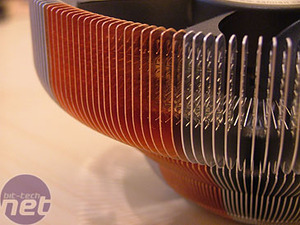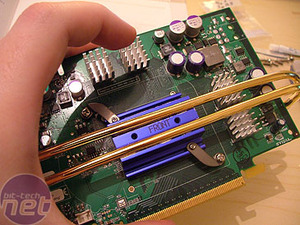Picking hardware for Media Center
September 5, 2005 | 13:25
Companies: #avermedia #hauppauge #microsoft #quiet-pc #zalman

Cooling
With all this hardware, probably packed into a very small space, you're going to need to think about how you're going to keep it all cooled. Not only that, but you want to keep it quiet, so that the roar of the waves in Titanic isn't drowned out by the roar of your CPU cooler, or the hum of a lightsaber in Star Wars isn't out-hummed by your case fans.What cooling you can go with will be primarily dictated by the size and shape of the chassis you have. If you chose a Shuttle box, most of the hard work will be done for you. Shuttle XPCs all include specialised CPU fans and PSU, so you don't have much choice as to how you cool the box. Luckily for you, Shuttle's cooling setups are almost always whisper quiet, so all you have to do is find a graphics card cooler that does the trick.
If you're building a half-height or micro-ATX box, chances are you're going to need a cooler suitable for 1U server modules. Unfortunately, low-noise is never a requirement for server products, so combined with their compact dimensions, this type of heatsink is inevitably going to be more whiney due to fan size. Something like this Dynatron cooler will be the order of the day (although you'll obviously need one to fit your specific socket).
If you plump for a full-ATX box, your options are wider and, to be honest, the chances of getting a silent system are far greater. When it comes to ludicrously quiet cooling, Zalman are pretty much kings of the hill. Why? Well, because they insist on making heatsinks with ridiculously large fans, and when you get a large fan, you can slow it down a whole bunch and still get great cooling. If you've got room in your case, we'd recommend the CNPS 7700 or 7000 series coolers, which are pictured below. These are outstanding coolers with either 120mm or 92mm fans on. They can be slowed down to near-silent whilst also maintaining good cooling capacity. If you have the height, another good cooler is the Arctic Cooling Freezer, which is a great performing cooler that's very quiet.


Graphics cooling
When it comes to graphics cooling, you have a couple of options. The first is to buy a graphics card which already has an incredibly quiet fan on it, possibly with dynamic control through the driver. A good example of this is the PowerColor X800GT.Alternatively, you can replace the cooler on your card with a completely passive variety, such as this baby from Zalman, pictured below. Bear in mind that if you go totally passive, you'll need to maintain decent airflow through the case to keep the card cool enough, since that Zalman heatsink will get very hot with a decent chip underneath.
If you can't keep everything cool with a completely passive cooler, go for something with a small-but-quiet heatsink and fan combo, like this.


Misc cooling
Number one - nobble the Northbridge. If you have a modern motherboard, chances are it has a fan on the Northbridge. Kill it! Northbridge fans tend to be annoying whiney, at a mere 40mm diameter. In a quiet system, they can easily be the loudest component. If you're not overclocking, and assuming some decent airflow and maybe an aftermarket Northbridge 'sink like this one, you'll be fine in terms of stability.You will be incredibly lucky if you can find a chassis that accommodates 120mm fans - you're going to have to make do with 80mm. In these cases, it's always better to have two 80mm fans on half speed than one on full-speed, if the chassis has capacity. These days, it's difficult to find 80mm fans that are much quieter than standard. You'll need to do the work yourself with a rev-limiter to take the edge of the noise. Either use a standard baybus, or a dedicated little doohicky like this.
A quick note on acoustic dampening material - it will make your case quieter by a tiny amount, but it will insulate heat like crazy. Unless you have incredibly awesome airflow, give it a miss.

MSI MPG Velox 100R Chassis Review
October 14 2021 | 15:04





Want to comment? Please log in.